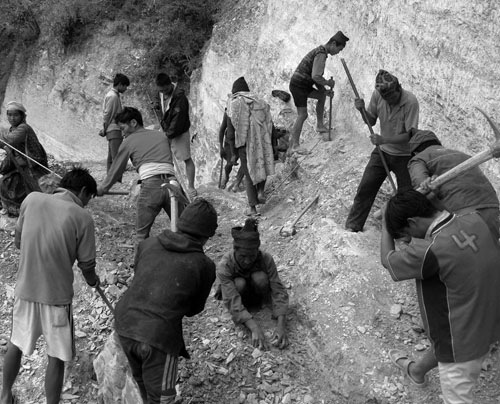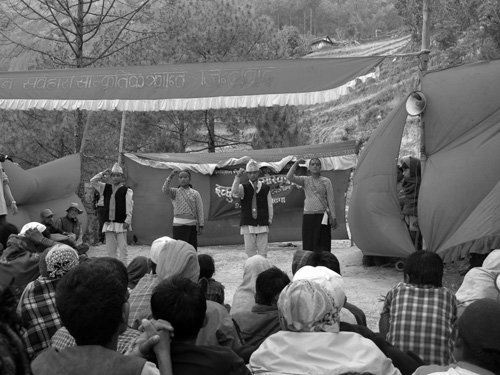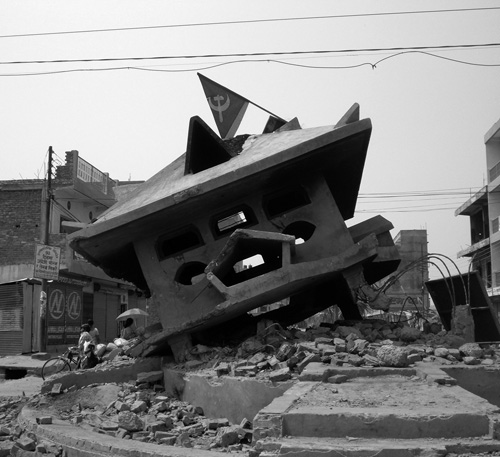| This article is an edited and shortened version of the Report from the Second International Road Building Brigade to Nepal (Britain and Ireland representatives).
|
As the Nepalese people's struggle against the autocratic feudal monarchy to establish a democratic republic hit a high point during the month of April, volunteers arrived to help build a 91-kilometre stretch of road known as the Martyrs Road. The Second International Road Building Brigade, drawing its members from Afghanistan, Iran, Scotland and England, gathered with the aim of journeying to Rolpa during April to work on this road.
While the old regime was being attacked and dismantled in the country's towns and cities, the challenge of building the new people's republic was continuing in the liberated zones of the Communist Party of Nepal (Maoist). Mass organisations set up by the elected Magarat Autonomous People's Republican Government in the main base area have been engaged in building a motorable road, helping to create the infrastructure of the new people's society.
As the group met up in Nepalgunj, Nepal saw nation-wide, anti-monarchist protests and a bandh (general strike) that not only closed all the shops and commercial outlets but also cleared all motor vehicles from the roads. Trapped in Nepalgunj, therefore, across the border from India, we were ideally placed to witness one of the many anti-monarchist protests outside of Kathmandu.

|
|
Workers on the Martyrs Road who have taken up tools in their own hands where no government or outside force has ever helped them.
|
Mass anger
A major focus for mass anger was Gyanendra Square, the central monument dedicated to the king. As we approached the monument a crowd of around 100 people had gathered and more police had arrived on the scene. Four piles of tires had been set on fire around the monument. We were all amazed at the audacity of the action, especially while the April Movement was only days old. Indeed, there was more to come for the monument to King Gyanendra!
As well as the fires, there were numerous demonstrations throughout the day, every day. Containing large numbers of women, these protests drew many from the Hindu, Muslim and Christian communities. As well as workers, peasants and students, civil servants, including doctors, lawyers, teachers and bank officials, marched through the streets. At most of the intersections were the remains of burning tyres, with new fires breaking out at regular intervals. A major focus for mass anger was Gyanendra Square, the central monument dedicated to the king, that was frequently surrounded by such fires in spite of having been given 24-hour paramilitary police protection.
The slogans chanted by the protesters left little room for reconciliation. As one of these marches approached the statue of Gyanendra's deeply unpopular grandfather, Tribhuvan, a man with a loudhailer called out, "What does Arayghat want?" the crowd responding with, "Arayghat wants Gyanendra". (Arayghat is the royal cemetery.) Also popular was the call to "Hang Paras from a tree". Gyanendra's son, Prince Paras is also much hated as a man who has committed both rape and murder but who has proved immune from legal action.
As the crowds became increasingly antagonistic, these minor protests rose in both numbers and militancy as the campaign intensified. After our work brigade had left, we were told on returning to the town by people who had been there, that a child had been shot dead and a woman had died after having first been beaten and then having a tear gas canister explode next to her. This occurred during a large protest that saw both the Gyanendra monument and the statue of Tribhuvan destroyed with lump hammers.
This People's Movement (often referred to in the media as the popular movement) was distinctly anti-monarchy, and against the Congress Party which is perceived as too close to the monarchy. Congress is renowned for its corruption and its inefficiency in previous governments. Most of the protesters by far appeared to be in favour of a republic, this being recognised as a more modern form of government than the existing feudal autocracy. Many spoke of achieving a British-style constitutional monarchy, although the cultivation of a constituent assembly and a republic were infinitely more popular. There was, however, also some concern among the protesters that the Seven Party Alliance leadership would compromise with the monarchy allowing the people's demand for a democratic republic to fall short. Within these protesting crowds, it was acknowledged that the Maoists were very much a part of the peoples' struggle and therefore part of the democratic agenda. The CPN(M) strategy at this time was to mobilise people in the villages around the major towns, organising them to swell the protests in the urban centres. In this way, the protests in the towns and cities tended to increase by tens of thousands as the campaign escalated.

|
|
A protest meeting against the brutal and corrupt monarchy.
|
The general strike looked set to prevent our group from reaching the liberated zones, and indeed to the Martyrs Road. Because of this, there appeared to be no alternative but to cross the border into India to buy bicycles so that three of us could push on. The others, due to their tighter schedule, were forced to remain behind.
Cycling out onto the Mahendra Highway our first stop as night was approaching was the village of Agaiya, around 50 km from where we had set off. A Communist Party of Nepal (United Marxist-Leninists) stronghold, the people appeared to be preparing to walk to Nepalgunj the following day to join the protests there. As darkness fell, the village children, sitting in a ring singing songs, suddenly decided to play a different game, that of protesters. Influenced by the events that were going on around them, a knot of children marched around the houses chanting, "Gyanendra is a thief, he must leave the country!"
After two days of cycling, covering 150 kilometres, we eventually reached Gorahi, the last city garrisoned by the RNA (Royal Nepal Army) before Rolpa, where our group encountered more large protests. Again villagers were coming in from Maoist areas to increase the protesters' numbers, playing a decisive role in the successes of the people's movement.
From Gorahi, cycling was impossible due to the mountain roads and we were forced to trek on up into the mountains. On the way, we met groups of people going to Gorahi, some taking breaks at the side of the road so women with children could breast feed.
We were made to feel very welcome by the locals, some of whom walked with us on our journey. When we stopped in small villages, someone would invariably walk out to offer us water. Right away, it seemed like a different world.
It was a journey of about 60 kilometres, the RNA and police influence ending immediately outside the northern exit from the city. Along the way, our group encountered the village of Holeri. A former police outpost, Holeri had been given up as too dangerous to man at night. The PLA, however, broke with its more common tactic of attacking at night to strike in the morning, destroying the outpost and any police that didn't flee. Now the village walls were decorated with slogans, posters and red flags as the CPN(M) stamped its territory.
Reaching Tilla Bazaar, nine days after we had been due to rendezvous there, the District Secretary of Rolpa, Comrade Kamal, on hearing of our arrival, walked for two hours across the mountain roads (on flip flops) to meet with us. Announcing that he would remain with us throughout our stay in the liberated zone, he was to accompany us to the Martyrs Road, introducing us to Comrade Surya, the co-ordinator of the road-building project.
In the short time that we were there, we spent much time in the company of these two men. Out on the Martyrs Road itself, at the group's welcoming ceremony, each member had a mark, or tika, symbolising the blood of the martyrs, put on our foreheads.
When the CPN(M) seized control of the Rolpa District from the monarchist regime, it drove out the local tyrants and carried out widespread land reform. In more recent times, experimental cooperatives and communes have been implemented and new co-operative banks have replaced usurers. At one point we were introduced to Comrade Birat, the head of the People's Cooperative Bank in the Rapti Zone, who proudly showed us the bank's documents and talked to us of the oppression of people during the old pre-liberation era.
In areas like Rolpa, road distances tend not to be measured in kilometres, but in the numbers of hours needed to walk. The Martyrs Road, planned to link the town of Nuwagaon to Thawang and Chunwang, and to connect many of the villages in the interior of Rolpa with the main district capital of Dang, Gorahi. Once complete, it is believed that the road will greatly improve travel within the district, making it easier for young people to access higher education and enable better access to medical treatment and the like. We were impressed by the general enthusiasm of the majority of the road workers and spoke to two volunteers who told us that they had come to work on the road, "for the development of the region and the country".
It is widely recognised, even among non-Maoists, that the road is an important step in this development. Built purely by the people with no outside help, using pickaxes, spades and dynamite, the road-building project avoids most of the main developmental problems including over-reliance on capital-intensive techniques, and overcomes the mindset of giving up if modern technology is unavailable.
As a country swamped by 'foreign aid', the Nepalese are well placed to recognise the problems inherent in such solutions. Given that under such a scheme labour would normally be paid to build the road, it would be open to wide-scale corruption that would ultimately drain away finance. There is, however, no room for corruption in the Maoist project, where the people see the immediate results of their labour.
As for the frequent accusations by western media that the road-building project depends on forced labour, workers are required to work no more than 15-20 days, once a year. Carried out during the slack agricultural seasons, people work for three hours a day, a fact confirmed by people we spoke to who were working on the road itself. There were also frequent breaks, the working days broken up by occasional cultural activities. Party leaders, cadres and PLA members also do voluntary work on the road throughout the year.

|
|
The hammer and sickle flag flies over a destroyed monument to the hated king.
|
'Our development, our effort'
The CPN(M)'s attempts to develop the country without depending on international imperialism arise from their clash of interests. The Nepali people want to develop the country for all, while the imperialist agenda is to keep countries that they call "developing" underdeveloped and dependent on foreign aid, loans, technology and expertise.
Using its own strengths to develop its own methods, as in Mao's China, the CPN(M) has utilised the road-building project to raise consciousness among the masses. Working under the slogan, "Our Development, Our Effort", they find what can be achieved collectively, increasing the self-confidence of the people, as their own techniques develop to overcome problems as they emerge.
Walking back to Gorahi, we met many groups of people on the road, again in loose knots, that gave us the lal salaam (red salute) as they returned homewards following the previous day's protests in the city. These greeted Kamal and Surya, who travelled with us the first part of the way, in a warm and enthusiastic manner, exchanging news. Among many of these groups, some carried transistor radios, tuned into news reports and playing as they walked. In fact, that very evening King Gyanendra announced that he would recall parliament with immediate effect.
The endeavour to send a work brigade to the liberated zones during this time, while being in the final analysis somewhat impractical, proved to be a great education for those of us involved. In deepening our understanding of the revolutionary process as it unfolds in Nepal, we are now better equipped to help build a solidarity movement in our countries to counter foreign interference and media lies about the revolution.
As our group said goodbye, Comrade Surya gave a speech as part of our farewell ceremony. Telling all that were assembled, that we were there to counter the lies and misinformation that journalists had been spreading in the west, he explained that the Martyrs Road was not just a road for Dang, but for the whole world.
As we left the gathering, with lines of Nepalese clapping, we carried with us Kamal's message: "We from our party request heartily to the people, to democrats from foreign countries, to come here and see the ground reality here with their own eyes, and to describe it materially, and expose such illusions and propagandas, false sayings. We give our solidarity to the people and request their solidarity to our movement here. Now we are fighting to establish a democracy here and we request you all to convey our red salutes to all the people, to our beloved people, to democratic people, and the people who are supporters of the WPRM. Lal Salaam!"


